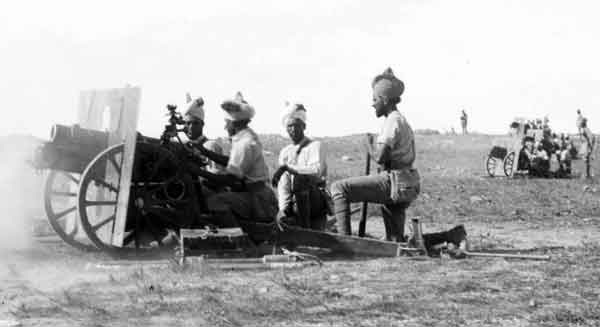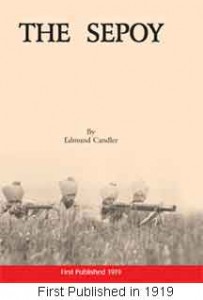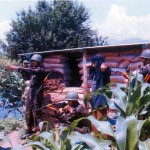I saw it stated in a newspaper that one of the surprises of the war has been the Mahratta. “Surprise” is hardly a tactful word; and it points back to a time when two or three classes of sepoy were praised indiscriminately to the disparagement of others. The war has brought about a readjustment of values. Not that the more tried and proven types have disappointed expectation; the surprise is that less conspicuous types have made good.
In France one heard a great deal about the Garhwali; in Mesopotamia the Cinderella of the Indian Army was undoubtedly the Mahratta.
If the modern Mahratta has fallen under an eclipse the cause has been largely geographical. Our frontier campaigns have never offered the Indian Army active service enough to go round…
That his emergence should be a surprise was illogical. The Mahratta horseman was once a name to conjure with, and the sword of Siwoji has left a dint in history legible enough. He was once the “Malbrovck” of Hindustan. If the modern Mahratta has fallen under an eclipse the cause has been largely geographical. Our frontier campaigns have never offered the Indian Army active service enough to go round; certainly the Bombay Army has not come in for its share, and Saihan, on the 15th of November, 1914, was the first pitched battle in which a Mahratta regiment, constituted as such, had been engaged. What honour he earned before that went to swell the collective prestige of class company regiments; for it was not until the Indian Army was reorganised in 1897 that the Mahratta battalion came into being.
The British officer, of course, in these regiments knew his sepoy; he believed that the Dekkan and Konkan produced as stout a breed as any other soil, and he would tell you so in the most definite terms, and remind you how the Mahrattas proved their mettle at Maiwand. But then one never listened seriously to a regimental officer when he talked about his own men.
The Sapper in a field company with divers races under his command is listened to with less suspicion. It was a Sapper who first opened my eyes to the virtue of a Mahratta, and that was before the war.
“Who do you think is the pick of your lot?” I asked.
“The Mahratta,” he replied, unhesitatingly. “Because he can dig?”
The Mahratta has no very marked charac-teristics to distinguish him from other sepoys. He is just the bedrock type of the Indian cultivator, the real backbone of the country.
“None better. But it is his grit I was thinking of. I’d as soon have a Mahratta with me in a scrap as any one.”
One heard little or nothing of the Mahratta in France. Yet it was a Mahratta who earned the Médaille Militaire—I believe the first bestowed on an Indian—for an unobtrusive bit of work at Givenchy on the 11th of December, 1914. We took a German saphead that day and drove the Huns down their communication trench, and then we had to sap back to our own lines, while another sap was being driven forward to meet us.
For twenty-three hours the small party was cut off from the rest of the lines, and they worked steadily with their backs to the enemy, bombed at and fired on the whole time. Supplies and ammunition ran short, and we threw them a rope with a stone on it, and they dragged ammunition and food and bombs into the trench, bumping over the German dead, and the Mahratta took his turn at the traverse covering the party, as cool as a Scot.
There were but a sprinkling of them in Flanders, a few Sappers and Miners and two companies of the 107th Pioneers. It was left to Force “D” to discover that the Mahratta has as big a heart for his size as any sepoy in the Indian Army. To follow the exploits of the Mahratta battalions from the battle of Saihan on the 15th November, 1914, to Ctesiphon is to follow the glorious history of the 6th Division. Up to and including Ctesiphon, no Mahratta battalion was given a position to attack which it did not take, and in the retirement on Kut-el-Amarah their steadiness was well proved. It is a record which is shared with other regiments; but this chapter is concerned with the Mahratta alone. They were in nearly every fight, and for a long time they made up a fourth part of the whole force.
The Mahratta battalions are not, strictly speaking, class regiments, for they each contain a double company of Dekkan Muhammadans.
It was the 117th who, with the Dorsets, took the wood, and cleared the Turks out of their trenches at Saihan. It was the 110th, with the Norfolks, who led the attack on Mazeera village on the 4th of December, clearing the left bank of the river; and a double company of the regiment captured the north face of the Qurnah position four days afterwards. Two battalions of the Mahrattas were in the front line again at Shaiba when the Turks were routed in one of the hardest fought and most critical battles of the campaign. They were at Nasiriyeh and Amara, and they were a tower of strength in the action at Sinn which gave us Kut-el-Amarah.
Here all three battalions—the 103rd, 110th, and 117th—were engaged. They went without water and fought three consecutive engagements in forty-eight hours. The 117th, with the Dorsets, and the 22nd company of Sappers and Miners, were the first troops to enter the enemy’s trenches. They broke through the wire and rushed the big redoubt, led by a subadar-major when all their British officers had fallen. At Ctesiphon again they covered themselves with glory. The British regiment brigaded with them speak well of these hard-bitten men, and many a villager of Dorset, Norfolk, or Oxford will remember the Mahratta, and think of him as a person one can trust.
“What was the Indian regiment on your right?” I heard a Norfolk man ask another, in discussing some obscure action on the Tigris of a year ago.
“The —— Mahrattas.”
The Bungay man nodded. “Ah, they wouldn’t leave you up a tree.”
“Not likely.”
The Mahratta sepoy is certainly no swash-buckler. To look at him, with his dark skin and irregular features, you would not take him for a member of a military caste.
And being familiar with the speech of Norfolk men, who are sparing of tribute, or admiration, or surprise, I knew that the “Mahratta” had received a better “chit” than even the Sapper had given him.
It was in the trenches, and I had been getting the Norfolks to tell me about the thrust up the river in the winter of 1914.
There was a lull in the firing. The Turks, 200 yards ahead, were screened from us by the parapet; and as I stood with my back to this looking eastward, there was nothing visible but earth and sky and the Norfolk men, and a patch of untrodden field, like a neglected lawn, running up to the next earth-work, and yellow with a kind of wild mustard. The flowers and grasses and a small yellow trefoil, wild barley, dwarf mallow, and shepherd’s purse were Norfolk flowers. They and the broad, familiar accent of the men made the place a little plot of Norfolk. Nothing Mesopotamian impinged on the homeliness of the scene.
And beyond the traverse were the Mahrattas, sons of another soil. They were a new draft, most of them mere boys who had come straight from the plough into this hard school. They looked dreamy and pensive, with a not very intelligent wistfulness, but they were ready for anything that was going on. Two of them were sniping from a loophole. One of them was shot in the shoulder through a sandbag while I was there. Soon after dark I saw a batch of six with an officer step over the parapet into that particularly horrid zone called no-man’s-land. They were to look for surface mines and to be careful not to tread on one. The bullets cracked against the parapet, but they were as casual as if they were going out to pick mushrooms.
The “mines” were charged shell-cases lying flat on the ground. The difficulty with these young recruits was to prevent them feeling for them with their feet or prodding them with a bayonet. They were quite untrained, but there was the same stuff in them as in the men who fought at Shaiba and Ctesiphon, and boasted that they had never been beaten by the Turks. A boy of seventeen who had gone out a few nights before was shot in the leg and lost his patrol. In the morning he found he was crawling up to the Turkish trenches. He was out all that day, but got back to his regiment at night, and all the while he hung on to his rifle.
The Subaltern had been a little depressed with this new batch of recruits. There was so little time to knock them into shape, and he was particularly pleased that Ghopade had brought back his rifle.
“They’ve got the right spirit,” he said. “It’s only a question of a month or two. But look at these children.”
They certainly did not look very smart or alert or particularly robust.
The Subaltern had been a little depressed with this new batch of recruits. There was so little time to knock them into shape, and he was particularly pleased that Ghopade had brought back his rifle.
“This one doesn’t look as if he could stick a Turk,” I said, and pointed to a thin hatchetfaced lad who could not have weighed much more than eight stone.
“Oh, I expect he’d do that all right. They are much wirier than you would think. It’s their turn-out I mean.”
“They’ve been in the trenches a week,” I said, by way of extenuation. But the Subaltern and I had passed by the —th and the —th in the same brigade, equally trench-bound, and they were comparatively spick and span.
The Mahratta sepoy is certainly no swash-buckler. To look at him, with his dark skin and irregular features, you would not take him for a member of a military caste. No one cares less for appearance; and his native dress—the big, flat pagri, dhoti, and large loose shoes of the Dekkan and Konkan—do not lend themselves to smartness. Nor does the King’s uniform bring with it an immediate transformation. The un-accustomed military turban, which the Sikh or Pathan ties deftly as if with one fold, falls about the head and down the neck of the Mahratta in the most capricious convolutions. If he is a Bayard he does not look the part, and looks, no doubt, as well as his geographical position, have stood in the way of his finding himself. Anyhow, the men who move the pawns on the board in the war-game had long passed him over.
They were to look for surface mines and to be careful not to tread on one. The bullets cracked against the parapet, but they were as casual as if they were going out to pick mushrooms.
The Mahratta battalions are not, strictly speaking, class regiments, for they each contain a double company of Dekkan Muhammadans. These, but for their inherited religion, are not very widely separated from the Mahrattas. They too have brought honour to the Dekkan. At Ctesiphon a double company of them were attacking a position. They lost all five officers, the British subaltern killed, two jemadars wounded, two subadars killed. One subadar, Mirza Rustum Beg, was wounded twice in the attack, but went on and received his death-wound within twenty-five yards of the enemy. The rest of the company went on, led by the havildars, and took the trench at the point of the bayonet.
That is not a bad record for a class of sepoy who has probably never been mentioned in the newspapers during the war. But it has been a war of “surprises,” and one of the morals of Mesopotamia is that one ought not to be sur-prised at anything. What the Mahratta and Dekkani Muhammadan have done may be expected from—has, indeed, been paralleled by—other hardened stocks. With good leading and discipline and the moral that tradition inspires, you can make good troops out of the agriculturist in most lands, provided he is not softened by a too yielding soil.
The Mahratta has no very marked charac-teristics to distinguish him from other sepoys. He is just the bedrock type of the Indian cultivator, the real backbone of the country. And he has all the virtues and limitations which you will find in the agriculturist whether he be Sikh, Rajput, Dogra, Jat, or Mussalman, whether he tills the land in the Dekkan or Peshawar. A prey to the priests, money-lenders and vakils, litigious, slow-thinking, unsophisticated—but of strong affections, long-enduring and brave. The small landowner, where the soil resists him and the elements chastise, is much the same all over the world.






